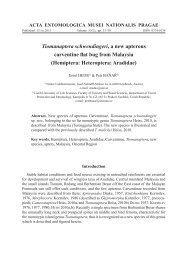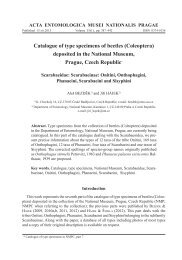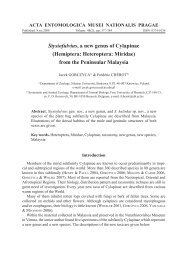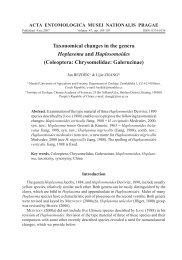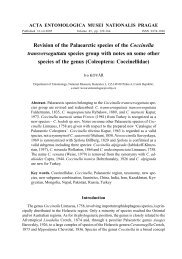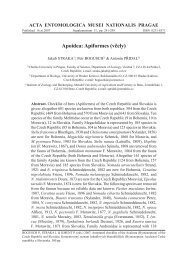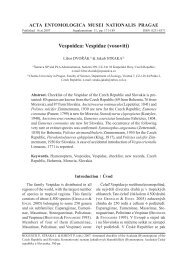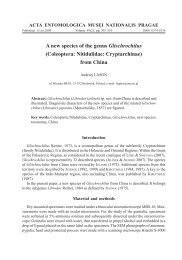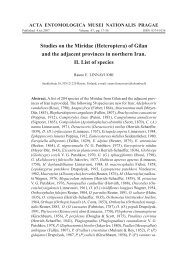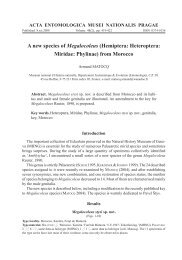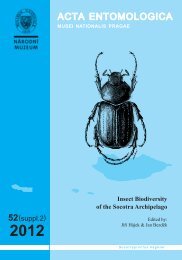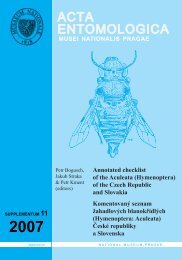ACTA ENTOMOLOGICA MUSEI NATIONALIS PRAGAE
ACTA ENTOMOLOGICA MUSEI NATIONALIS PRAGAE
ACTA ENTOMOLOGICA MUSEI NATIONALIS PRAGAE
Create successful ePaper yourself
Turn your PDF publications into a flip-book with our unique Google optimized e-Paper software.
<strong>ACTA</strong> <strong>ENTOMOLOGICA</strong> <strong>MUSEI</strong> <strong>NATIONALIS</strong> <strong>PRAGAE</strong><br />
Published 15.xii.2010 Volume 50(2), pp. 425–436 ISSN 0374-1036<br />
Annotated catalogue of the Iranian broad-headed bugs<br />
(Hemiptera: Heteroptera: Alydidae)<br />
Hassan GHAHARI 1) , Diego Leonardo CARPINTERO 2) , Pierre MOULET 3) ,<br />
Rauno E. LINNAVUORI 4) & Hadi OSTOVAN 5)<br />
1) Department of Entomology, Islamic Azad University, Science and Research Branch, Tehran, Iran;<br />
e-mail: hghahari@yahoo.com<br />
2) División Entomología, Museo Argentino de Ciencias Naturales «Bernardino Rivadavia». Av. A. Gallardo 470<br />
Ciudad A. de Buenos Aires, 1405; Argentina; e-mail: dcarpint@macn.gov.ar<br />
3) Museum Requien, 67 rue Joseph Vernet, F-84000 Avignon; France;<br />
e-mail: musee.requien@mairie-avignon.com<br />
4) Saukkokuja 10, FIN-21220 Raisio, Finland; e-mail: rauno.linnavuori@kolumbus.fi<br />
5) Department of Entomology, Fars Science and Research Branch, Islamic Azad University, Marvdasht, Iran;<br />
e-mail: ostovan2001@yahoo.com<br />
Abstract. The fauna of Iranian broad-headed bugs (Coreoidea: Alydidae) is studied<br />
in this paper. A total of twenty-one species of eleven genera (Alydus Fabricius,<br />
1803, Camptopus Amyot & Serville, 1843, Euthetus Dallas, 1852, Heegeria<br />
Reuter, 1881, Megalotomus Fieber, 1860, Mirperus Stål, 1860, Nariscus Stål,<br />
1865, Nemausus Stål, 1866, Riptortus Stål, 1859, Tenosius Stål, 1860, Leptocorisa<br />
Latreille, 1829) belonging to two subfamilies (Alydinae, Leptocorisinae)<br />
are listed for Iranian fauna. Out of them, three species, Megalotomus junceus<br />
(Scopoli, 1763), M. ornaticeps (Stål, 1858) and Leptocorisa oratoria (Fabricius,<br />
1794), are new records for Iran.<br />
Keywords: Heteroptera, Coreoidea, Alydidae, fauna, catalogue, Iran<br />
Introduction<br />
The broad-headed bugs (Alydidae) are a cosmopolitan family of coreoid bugs. About 50<br />
genera and over 200 species are known worldwide (DOLLING 2006), with most species occurring<br />
in the subtropical and tropical regions of the world; for example, Europe has a mere 10<br />
species, and only four of them occur outside the Mediterranean region (SLATER 1982, SCHUH<br />
& SLATER 1995, DOLLING 2006).
426<br />
Fig. 1. Map of Iran with boundaries of provinces.<br />
GHAHARI et al.: Annotated catalogue of the Iranian Alydidae<br />
Most species of the Alydidae are characterized by their elongate and slender form and<br />
often elongate appendages. They are often dull grey-brown in color. Some species mimic<br />
ants (particularly the larvae) or wasps. The head width is greater than half the width of the<br />
posterior margin of the pronotum. The bucculae never exceed the antenniferous tubercles.<br />
The antennae are inserted dorsal to the midline of the eye. The metathoracic scent glands<br />
have a single small sac, and their external scent efferent system has a distinct peritreme. The<br />
membrane of the hemelytra has numerous veins. The abdominal trichobothria are lateral<br />
and sublateral on sterna V-VII and submedial on sterna III and IV. The male and female<br />
genitalia are diagnostic (AHMAD & SOUTHWOOD 1964, SCHAEFER 1975, MCIVER & STONEDAHL<br />
1993, SCHUH & SLATER 1995).<br />
The alydids were first recognized as a family by AMYOT & SERVILLE (1843), a ranking that<br />
has been followed by most subsequent authors (e.g., SCHAEFER 1965, SLATER 1982, SCHUH &<br />
SLATER 1995). STÅL (1867) regarded them as a subfamily of the Coreidae; however, despite<br />
their close relationship, this classification has had little modern usage. SCHAEFER (1965)<br />
identified two subfamilies, the Alydinae and Micrelytrinae, with the latter divided into two<br />
tribes (Micrelytrini and Leptocorisini). AHMAD (1965) raised the Leptocorisini to a subfami-
Acta Entomologica Musei Nationalis Pragae, 50(2), 2010 427<br />
ly, thereby recognizing three alydid subfamilies. Until recently, this arrangement had been<br />
followed by most authors (SCHAEFER 1980, 1996; FROESCHNER 1988). LI & ZHENG (1993) provided<br />
a cladistic classification of the alydids supporting SCHAEFER’s (1965) division into two<br />
subfamilies. SCHAEFER (1999) reviewed the morphology and classification of the alydids and<br />
established the following classification: Alydinae (Alydini and Daclerini) and Micrelytrinae<br />
(Micrelytrini and Leptocorisini: Leptocorisina and Noliphina).<br />
LETHIERRY & SEVERIN (1894) is the most recent bibliographic treatment of the world<br />
fauna of the family. A number of regional catalogues of Heteroptera exist: for Palaearctic<br />
Region (OSHANIN 1906, 1912; DOLLING 2006), Nearctic Region (FROESCHNER 1988), Ecuador<br />
(FROESCHNER 1981), Panama (FROESCHNER 2000) and Australia (CASSIS & GROSS 2002). The<br />
Alydidae have received little modern monographic treatment. The most important revisionary<br />
works are: STÅL (1859, 1867, 1873 – world), FRACKER (1918 – Nearctic Region), GROSS (1963<br />
– Micronesia), SCHAFFNER (1964 – world), AHMAD (1965 – world Leptocorisini), BRAILOVSKY &<br />
ZURBIA FLORES (1979 – Mexico), HSIAO (1977 – China), LINNAVUORI (1987 – West and Central<br />
Africa), BRAILOVSKY (1991 – Neotropical Region), MOULET (1995 – West Palaearctics) and<br />
GÖLLNER-SCHEIDING (2000 – Afrotropical Region).<br />
Alydids are phytophagous on either vegetative material or ripe and unripe seeds mainly<br />
belonging to Fabaceae. These bugs often inhabit semiarid and sandy habitats like seashores,<br />
heathland, steppe and savannas. Their main food is seeds that they pierce with their rostrum<br />
to suck the nutritious fluids contained within. Some are economically significant pests, for<br />
example Leptocorisa oratoria (Fabricius, 1794) on rice (reviewed by PANIZZI et al. (2000)).<br />
Cannibalism is known at least in some Alydinae; some of them are occassionally coprophagous<br />
or necrophagous (MOULET 1995, CONSTANT 2007). SCHAEFER (1980), SCHAEFER &<br />
MITCHELL (1983) and SCHUH & SLATER (1995) summarized their feeding habits and host plant<br />
relationships.<br />
Although Iran is a large country with diverse climate and flora, the biodiversity of Iranian<br />
Heteroptera is underestimated and especially family Alydidae was studied very poorly before<br />
this project. The only comprehensive paper on the Iranian Alydidae is the review by HOBER-<br />
LANDT (1985). MODARRES AWAL (1997b) listed three species among agricultural pests in Iran,<br />
i.e. Camptopus lateralis (Germar, 1817), C. tragacanthae (Kolenati, 1845) and Riptortus<br />
linearis (Fabricius, 1775).<br />
The objective of this research is to describe the fauna of the Iranian Alydidae, and this paper<br />
is a continuation of the series of annotated catalogues of Heteroptera of Iran (see GHAHARI<br />
et al. 2009a,b, 2010).<br />
Materials and methods<br />
The specimens were collected by sweeping of vegetation and by light traps method from<br />
various cultivated plants and weeds in different locations of Iran. Also, many specimens from<br />
different insect collections of Iranian universities (especially different branches of Islamic Azad<br />
University) were checked, and their data have also been included in this paper. In addition to<br />
the specimens, all published records on Iranian Alydidae were revised by the authors.
428<br />
GHAHARI et al.: Annotated catalogue of the Iranian Alydidae<br />
Results<br />
In a total, 2 subfamilies, 11 genera and 21 species of Alydidae are listed as the fauna of<br />
Iran. Among them, 3 species are new records for Iran. The list of the Iranian alydid species<br />
is given below. For full synonymy see DOLLING (2006).<br />
Family ALYDIDAE Amyot & Serville, 1843<br />
Subfamily Alydinae Amyot & Serville, 1843<br />
The Alydinae are the most diverse alydid subfamily and are found in all major zoogeographic<br />
regions (Schaefer 1964).<br />
Genus Alydus Fabricius, 1803<br />
Alydus calcaratus (Linnaeus, 1758)<br />
Distribution in Iran. Northern Iran (JAKOVLEV 1877; OSHANIN 1906, 1912), Tehran (HOBER-<br />
LANDT 1985).<br />
General distribution. Widespread in Europe, Morocco, North and Central Asia; also present<br />
in Nearctic Region (DOLLING 2006).<br />
Genus Camptopus Amyot & Serville, 1843<br />
Camptopus bifasciatus Fieber, 1864<br />
Distribution in Iran. Fars (WAGNER 1961, HOBERLANDT 1985, LINNAVUORI 2007), Guilan<br />
(LINNAVUORI 2007), Kerman (HOBERLANDT 1985), Semnan (KIRITSHENKO 1938), Tehran<br />
(LINDBERG 1938).<br />
General distribution. Armenia, Azerbaijan, Iran, Turkey (DOLLING 2006).<br />
Camptopus illustris Horváth, 1899<br />
Distribution in Iran. Fars (HOBERLANDT 1955, 1985), West Azarbaijan (HOBERLANDT<br />
1985).<br />
General distribution. Armenia, Azerbaijan, Iran, Iraq, Turkey (DOLLING 2006).<br />
Camptopus lateralis (Germar, 1817)<br />
Distribution in Iran. Ardabil (MODARRES AWAL 1996a,b), East Azarbaijan (SADAGHIAN et<br />
al. 2002, KHALILZADEH et al. 2006, KHALILZADEH 2008, HASSANZADEH et al. 2009, GHARAAT<br />
et al. 2009, KHAGHANINIA et al. 2010a,b), Fars (WAGNER 1968, HOBERLANDT 1985), Golestan<br />
(HOBERLANDT 1985, HEISS 2002, LINNAVUORI 2007), Guilan (HOBERLANDT 1985, LINNAVUORI<br />
2007), Kerman (HOBERLANDT 1955), Khorasan (HOBERLANDT 1985, HAVASKARY et al. 2010),<br />
Khuzestan (HOBERLANDT 1955), Mazandaran (WAGNER 1968, HOBERLANDT 1985, LINNAVUORI<br />
2007), Semnan (LINNAVUORI 2007), Tehran (LINDBERG 1938; HOBERLANDT 1955, 1985; BROWN<br />
1966; LINNAVUORI 2007), West Azarbaijan (HOBERLANDT 1985).
Acta Entomologica Musei Nationalis Pragae, 50(2), 2010 429<br />
General distribution. Holo-Mediterranean, extending to south of Central Europe and Central<br />
Asia in the north, and Pakistan and India in the east (DOLLING 2006).<br />
Comment. YARMAND et al. (2002) reported C. lateralis from the forests of Iran, but without<br />
exact locality.<br />
Camptopus tragacanthae (Kolenati, 1845)<br />
Distribution in Iran. Ardabil (LINNAVUORI 2007), East Azarbaijan (MODARRES AWAL 1996b,<br />
1997a; SADAGHIAN et al. 2002), Golestan (HEISS 2002), Guilan (LINNAVUORI 2007), Kerman<br />
(BROWN 1966), Khorasan (MODARRES AWAL 1997b, 2008), Sistan & Baluchestan (KIRITSHEN-<br />
KO 1966, SEIDENSTÜCKER 1957), Tehran (LINDBERG 1938, HOBERLANDT 1955, BROWN 1966,<br />
LINNAVUORI 2007).<br />
General distribution. Distributed from Asian part of Turkey and Transcaucasia towards<br />
southwestern Russia, and through the Central Asia to Afghanistan and northwestern China<br />
(DOLLING 2006).<br />
Genus Euthetus Dallas, 1852<br />
Euthetus humilis Horváth, 1907<br />
Distribution in Iran. Hormozgan (HOBERLANDT 1985).<br />
General distribution. Canary Islands, Libya, Tunisia, Israel, Iran and tropical Africa (DOL-<br />
LING 2006).<br />
Euthetus pallescens Distant, 1902<br />
Distribution in Iran. Hormozgan (HOBERLANDT 1985).<br />
General distribution. Iran and tropical Africa (DOLLING 2006).<br />
Euthetus pulchellus Dallas, 1852<br />
Distribution in Iran. Hormozgan (WAGNER 1968, LINNAVUORI 2004), Sistan & Baluchestan<br />
(SEIDENSTÜCKER 1957, HOBERLANDT 1985).<br />
General distribution. Iran and Oriental Region (DOLLING 2006).<br />
Genus Heegeria Reuter, 1881<br />
Heegeria tangirica (Saunders, 1877)<br />
Distribution in Iran. Hormozgan (HOBERLANDT 1985, as Tenosius tangiricus; LINNAVUORI<br />
2004), Kerman (SEIDENSTÜCKER 1958, as Tenosius tangiricus), Sistan & Baluchestan (HOBER-<br />
LANDT 1985, as Tenosius tangiricus).<br />
General distribution. Greece (Crete), Italy, Spain, Egypt, Morocco, Israel, Oman, Yemen,<br />
Iran, Pakistan and tropical Africa (DOLLING 2006).
430<br />
GHAHARI et al.: Annotated catalogue of the Iranian Alydidae<br />
Genus Megalotomus Fieber, 1860<br />
Megalotomus junceus (Scopoli, 1763)<br />
Material examined. MAZANDARAN: Ramsar (48 m), Summer 2002, 1 �, H. Ghahari leg., D. L. Carpintero det.<br />
New record for Iran.<br />
General distribution. Central, southeastern and eastern Europe, Asian part of Russia Kazakhstan,<br />
Mongolia, northern China, and Korea (DOLLING 2006).<br />
Megalotomus obtusus Ghauri, 1972<br />
Distribution in Iran. Sistan & Baluchestan (HOBERLANDT 1985).<br />
General distribution. Iran and Pakistan (DOLLING 2006).<br />
Megalotomus ornaticeps (Stål, 1858)<br />
Material examined. EAST AZARBAIJAN: Arasbaran (837 m), September 2004, 1 � 3 ��, M. Havaskary leg., D. L.<br />
Carpintero and R. E. Linnavuori det. New record for Iran.<br />
General distribution. Steppe zone of eastern Europe and Asia from Ukraine to Transcaucasia,<br />
northern China and West Siberia (DOLLING 2006).<br />
Genus Mirperus Stål, 1860<br />
Mirperus demetrii (Kiritshenko, 1966)<br />
Distribution in Iran. Hormozgan (KIRITSHENKO 1966, as Dolichocamptopus demeterii; HOBER-<br />
LANDT 1985), Sistan & Baluchestan (KIRITSHENKO 1966, as Dolichocamptopus demeterii).<br />
General distribution. Iran and tropical Africa (Kenya, Sudan) (DOLLING 2006).<br />
Mirperus torridus (Westwood, 1842)<br />
Distribution in Iran. Hormozgan (HOBERLANDT 1985, as M. jaculus; LINNAVUORI 2004).<br />
General distribution. Tropical Africa, Sinai, Yemen, Saudi Arabia, Iran and Pakistan<br />
(DOLLING 2006).<br />
Comment. HOBERLANDT (1985) considered Mirperus torridus to be a junior synonym of M.<br />
jaculus (Thunberg, 1783). However, this synonymy was not accepted by subsequent authors<br />
(e.g., LINNAVUORI 1987, GÖLLNER-SCHEIDING 2000) (see DOLLING 2006).<br />
Genus Nariscus Stål, 1865<br />
Nariscus conspurcatus Mancini, 1946<br />
Distribution in Iran. Hormozgan (LINNAVUORI 2004).<br />
General distribution. Tropical Africa, Yemen, Oman, Saudi Arabia, Iran, and Afghanistan<br />
(DOLLING 2006).
Acta Entomologica Musei Nationalis Pragae, 50(2), 2010 431<br />
Nariscus spinosus (Burmeister, 1835)<br />
Distribution in Iran. Hormozgan (HOBERLANDT 1955, 1985), Kerman (SEIDENSTÜCKER 1958),<br />
Sistan & Baluchestan (HOBERLANDT 1955, misidentified as N. cinctiventris; HOBERLANDT<br />
1985).<br />
General distribution. Tropical Africa, Algeria, Egypt, Cyprus, Saudi Arabia, Yemen, Oman,<br />
and Iran (DOLLING 2006).<br />
= Nemausus simplex Horvath, 1911<br />
Genus Nemausus Stål, 1866<br />
Nemausus sordidatus (Stål, 1858)<br />
Distribution in Iran. Hormozgan (HOBERLANDT 1985, as N. simplex; LINNAVUORI 2004).<br />
General distribution. Spain, Canary Islands, northern and tropical Africa, Yemen, Oman,<br />
Saudi Arabia, Israel, Jordan and Iran (DOLLING 2006). The record from Poland (as ‘PL!’) by<br />
DOLLING (2006) is undoubtedly an error (cf. LIS et al. 2008) and most likely concerns Portugal<br />
(P. Moulet).<br />
Comment. Nemausus simplex Horváth, 1911 was synonymized with N. sordidatus by LIN-<br />
NAVUORI (2004).<br />
Genus Riptortus Stål, 1859<br />
Riptortus aegyptiacus Lindberg, 1939<br />
Distribution in Iran. Sistan & Baluchestan (HOBERLANDT 1985).<br />
General distribution. Egypt, Saudi Arabia and Iran (DOLLING 2006).<br />
Riptortus linearis (Fabricius, 1775)<br />
Distribution in Iran. Hormozgan (HOBERLANDT 1985, LINNAVUORI 2004), Kerman (HOBER-<br />
LANDT 1985), Khorasan (MODARRES AWAL 1996b), Sistan & Baluchestan (SEIDENSTÜCKER<br />
1957).<br />
General distribution. Iraq, Iran, China, Taiwan, Japan, Oriental and Australasian Regions<br />
(DOLLING 2006).<br />
Genus Tenosius Stål, 1860<br />
Tenosius proletarius (Schaum, 1853)<br />
Distribution in Iran. Fars (HOBERLANDT 1985), Hormozgan (HOBERLANDT 1985, LINNAVUORI<br />
2004), Kerman (HOBERLANDT 1985), Sistan & Baluchestan (HOBERLANDT 1985).<br />
General distribution. Canary Islands, Libya, Israel, Yemen, Oman, Saudi Arabia, Iran,<br />
tropical Africa and Oriental Region (DOLLING 2006).
432<br />
GHAHARI et al.: Annotated catalogue of the Iranian Alydidae<br />
Subfamily Leptocorisinae Stål, 1872<br />
Genus Leptocorisa Latreille, 1829<br />
Leptocorisa oratoria (Fabricius, 1794)<br />
Material examined. ISFAHAN: Isfahan (1588 m), July 1999, 1 �, H. Masjedian leg., D. L. Carpintero det. New<br />
record for Iran.<br />
General distribution. China, Japan, Oriental and Australasian Regions (DOLLING 2006).<br />
Comment. Both the adults and nymphs feed on grains at the milking stage (especially wheat<br />
and barley). Feeding causes empty or small grains during the milking stage. At the soft or<br />
hard dough stage, feeding causes deformed or spotty grains. The grains become dark as a<br />
result of spilling of endosperm. The spillage becomes a medium for fungal infection. Since<br />
the eggs of Leptocorisa spp. are parasitized by Gryon spp. (Scelionidae) and Ooencyrtus<br />
spp. (Encyrtidae) (CORBETT 1930, AKBAR 1958, AHMAD 1965, REISSIG et al. 1986), and some<br />
specimens of Gryon sp. (near to G. nixoni Masner, 1965) and Ooencyrtus sp. were collected<br />
from Isfahan, they can probably be efficient parasitoids of L. oratoria in this region.<br />
Discussion<br />
The results of the present paper indicate that 21 species of 11 genera were identified from<br />
Iran so far. Iran is a large country incorporating various geographical regions and climates<br />
(Fig. 1), and we suppose that a large number of species remain to be discovered. To find<br />
new species and distributional records, more studies should be conducted on the Alydidae<br />
in all regions of Iran.<br />
Also, the host associations of Iranian alydids are poorly known. The majority of the alydine<br />
species in Iran are found on legumes. Riptortus linearis is a pest of legumes but it is also<br />
known from several unrelated host plants. The host associations of the Leptocorisinae are<br />
better known. SANDS (1977) provided a detailed account of the biology of the Leptocorisa<br />
species in Papua New Guinea outlining their life histories, host associations and crop damage.<br />
The works conducted on host plants of the world Alydidae are rather limited (SCHAEFER 1980).<br />
Determining of host plants and natural enemies (especially parasitoids) of alydids in Iran and<br />
also other regions of the world can be the important and invaluable research work.<br />
Acknowledgements<br />
The authors are indebted to Petr Kment (National Museum, Prague, Czech Republic) for<br />
preparing the manuscript for publishing and sending several necessary papers. We thank to<br />
C. W. Schaefer (University of Connecticut, USA), late I. M. Kerzhner (Russian Academy<br />
of Sciences) and H. Sakenin (Ghaemshhahr Islamic Azad University) for invaluable help<br />
in progress of the project. The research was supported by Islamic Azad University (Tehran<br />
Science and Research Branch), Consejo Nacional de Investigaciones Científicas y Técnicas<br />
(CONICET, Argentina) and Museum Requien, France.
Acta Entomologica Musei Nationalis Pragae, 50(2), 2010 433<br />
References<br />
AHMAD I. 1965: The Leptocorisinae (Heteroptera: Alydidae) of the world. Bulletin of the British Museum (Natural<br />
History), Entomolgy, Supplemet 5: 1–156.<br />
AHMAD I. & SOUTHWOOD T. R. E. 1964: The morphology of the alydid abdomen with special reference to the<br />
genitalia and its bearing on classification (Heteroptera). Tijdschrift voor Entomologie 107: 1–42.<br />
AKBAR S. S. 1958: The morphology and life history of Leptocorisa varicornis Fabr. (Coreidae: Hemiptera): a pest<br />
of paddy crop in India. Part II. Abdomen, internal anatomy and life-history. Aligarh Muslim University Publications<br />
(Zoological Series) 1(7): 1–50 + pls.<br />
AMYOT C. J. B. & SERVILLE A. 1843: Histoire Naturelle des Insectes. Hémiptères. Fain et Thunot, Paris,<br />
675 pp.<br />
BRAILOVSKY H. 1991: Hemiptera-Heteroptera from Mexico. LXIII. A new genus and three new species of<br />
Neotropical Micrelytrinae (Alydidae) collected on bamboos. Journal of the New York Entomological Society<br />
99: 487–495.<br />
BRAILOVSKY H. & ZURBIA FLORES R. 1979: Contribución al estudio de los Hemiptera-Heteroptera de México:<br />
XVII. Revision de la familia Alydidae Amyot y Serville. Anales del Instituto de Biología, Universidad Nacional<br />
Autónoma de México, Serie Zoología 50: 255–339.<br />
BROWN E. S. 1966: An account of the fauna associated with Eurygaster integriceps Put. and Aelia species (Hem.,<br />
Pentatomoidea) in their overwintering areas in the Middle East. Entomologist’s Monthly Magazine 102: 29–46<br />
+ 4 unpaginated pls.<br />
CASSIS G. & GROSS G. F. 2002: Hemiptera: Heteroptera (Pentatomomorpha). In: HOUSTON W. W. K. & WELLS<br />
A. (eds.): Zoological Catalogue of Australia. Vol. 27.3B. CSIRO, Melbourne, xiv + 737 pp.<br />
CONSTANT J. 2007: Note on coprophily and necrophily in the Hemiptera Heteroptera. Bulletin de l’Institut Royal<br />
des Sciences Naturelles de Belgique, Entomologie 77: 107–112.<br />
CORBETT G. H. 1930: The bionomics and control of Leptocorisa acuta (Thunberg) with notes on Leptocorisa spp.<br />
Malaya Department of Agriculture S.S. and F.M.S. Science Series 4: 1–40.<br />
DOLLING W. R. 2006: Superfamily Coreoidea Leach, 1815. Pp. 1–101. In: AUKEMA B. & RIEGER Ch. (eds.):<br />
Catalogue of the Heteroptera of the Palaearctic Region. Vol. 5, Pentatomomorpha II. The Netherlands Entomological<br />
Society, Amsterdam, xiii + 550 pp.<br />
FRACKER S. B. 1918: The Alydinae of the United States. Annals of the Entomological Society of America 11:<br />
255–280.<br />
FROESCHNER R. C. 1981: Heteroptera or true bugs of Ecuador: a partial catalog. Smithsonian Contributions to<br />
Zoology 322: i–iv + 1–147.<br />
FROESCHNER R. C. 1988: Alydidae. Pp. 4–11. In: HENRY T. J. & FROESCHNER R. C. (eds.): Catalog of<br />
the Heteroptera, or True Bugs, of Canada and the Continental United States. E. J. Brill, Leiden, New York,<br />
København, Köln, xix + 958 pp.<br />
FROESCHNER R. C. 2000: True Bugs (Heteroptera) of Panama: A synoptic catalog as a contribution to the study<br />
of Panamanian biodiversity. Memoirs of the American Entomological Institute 62: i–ii + 1–393.<br />
GHAHARI H., CARPINTERO D. L. & OSTOVAN H. 2009a. An annotated catalogue of the Iranian Anthocoridae<br />
(Hemiptera: Heteroptera: Cimicomorpha). Acta Entomologica Musei Nationalis Pragae 49: 43–58.<br />
GHAHARI H., CHÉROT F., LINNAVUORI R. E. & OSTOVAN H. 2009b: Annotated catalogue of Iranian burrower<br />
bugs (Heteroptera, Pentatomoidea, Cydnidae). ZooKeys 26: 1–31.<br />
GHAHARI H., LINNAVUORI R. E., MOULET P. & OSTOVAN H. 2010: An annotated catalogue of the Iranian<br />
Nabidae (Hemiptera: Heteroptera). Acta Entomologica Musei Nationalis Pragae 50: 33–44.<br />
GHARAAT M. A., HASSANZADEH M., SAFARALIZADEH M. H. & FALLAHZADEH M. 2009: Notes on the<br />
true bug (Heteroptera) fauna of Azerbaijan province, Iran. Turkish Journal of Zoology 33: 421–431.<br />
GÖLLNER-SCHEIDING U. 2000: Die Alydinae Afrikas (Insecta: Heteroptera: Coreoidea: Alydidae). Entomologische<br />
Abhandlungen Staatliches Museum für Tierkunde Dresden 59: 5–53.<br />
GROSS G. F. 1963: Insects of Micronesia. Coreidae (Alydini by J. C. Schaffner), Neididae, and Nabidae. Insects<br />
of Micronesia 7: 357–390.
434<br />
GHAHARI et al.: Annotated catalogue of the Iranian Alydidae<br />
HASSANZADEH M., FARSHBAF POURABAD R. & SHAYESTEH N. 2009: An investigation on some Heteroptera<br />
in Marand region. Munis Entomology and Zoology 4: 19–24.<br />
HAVASKARY M., HOSSEIN POUR F. H. & MODARRES AWAL M. 2010: Cimicomorpha and Pentatomomorpha<br />
(Heteroptera) of alfalfa from Mashhad and vicinity, NE Iran. Munis Entomology and Zoology 5: 253–261.<br />
HEISS E. 2002: Beitrag zur Kenntnis der Wanzenfauna (Heteroptera) Irans, I. Pp. 87–97. In: GUTLEB B. & WIESER<br />
Ch. (eds): Ergebnisse einer zoologischen Exkursion in den Nordiran, 2001. Carinthia II 112: 33–140.<br />
HOBERLANDT L. 1955: Hemiptera – Heteroptera from Iran, I. Acta Entomologica Musei Nationalis Pragae 29<br />
(1954): 121–148.<br />
HOBERLANDT L. 1985: Results of the Czechoslovak-Iranian entomological expedition to Iran, 1970, 1973 and<br />
1977. Heteroptera: Alydidae. Acta Musei Nationalis Pragae B 41: 239–259.<br />
HSIAO T.-Y. 1977: (Coreidae, Stenocephalidae). Pp. 39–52, 295–297. In: HSIAO T.-Y., JEN S.-C. [= REN<br />
Sh.-Zh.], CHENG L.-I. [= ZHENG L.-Y.], CHING H.-L. [= JING H.-L.] & LIU S. L.: A handbook for the<br />
determination of the Chinese Hemiptera: Heteroptera. Vol. 1. Science Press, Beijing, iii + 330 pp (in Chinese,<br />
English summary).<br />
JAKOVLEV V. E. 1877: Poluzhestkokrylya (Hemiptera Heteroptera) severnoy Persii. [True bugs (Hemiptera Heteroptera)<br />
of northern Iran]. Trudy Russkago Entomologicheskago Obshchestva 10: 67–98 (in Russian).<br />
KHAGHANINIA S., ASKARI O., FARSHBAF POUR ABAD R. & SHAHIM K. 2010a: Some additional notes<br />
about Heteroptera fauna of Qaradag forests–Iran. Munis Entomology and Zoology 5: 513–518.<br />
KHAGHANINIA S., FARSHBAF POUR ABAD R., ASKARI, O. & FENT M. 2010b: An introduction to true bugs<br />
fauna of Gunber valley including two new records for Iranian fauna (Hemiptera: Heteroptera). Munis Entomology<br />
and Zoology 5: 354–360.<br />
KHALILZADEH A. 2008: Identification of Heteroptera fauna of alfalfa fields in Azarshahr region of Azarbayejane-sharqi<br />
province, Iran. Journal of New Agricultural Science 4(9): 5.<br />
KHALILZADEH A., FARSHBAF POURABAD R., KAZEMI M. H. & OSTOVAN H. 2006: Fauna of Heteroptera<br />
of Azarshahr, East Azarbayjan. Journal Forest and Pasture 76 & 77: 77–83.<br />
KIRITSHENKO A. N. 1938: Nastoyashchie poluzhestkokrylye nasekomye (Hemiptera) Nakhichevanskoy ASSR.<br />
(Die echten Halbflügler (Hemiptera) der Nakhitschewan ASSR). Trudy Zoologicheskogo Instituta Azerbaidzhanskii<br />
Filial Akademiya Nauk SSSR viii/42: 75–121 (in Russian, German summary).<br />
KIRITSHENKO A. N. 1966: Nastoyashchie poluzhestkokrylye (Hemiptera–Heteroptera), sobrannye D. M. Shteynbergom<br />
v 1955 g. v Irane. (Hemiptera–Heteroptera collected by D. M. Steinberg in Iran in 1955). Entomologicheskoe<br />
Obozrenie 45: 798–805 (in Russian, English title).<br />
LETHIRERRY L. & SEVERIN G. 1894: Catalogue Général des Hémiptères. Tome II. Hétéroptères Coreidae,<br />
Berytidae, Lygaeidae, Pyrrhocoridae. F. Hayez, Bruxelles, 277 pp.<br />
LI X.-Z. & ZHENG L.-Y. 1993: Preliminary study on the phylogeny of Alydidae (Hemiptera: Coreoidea). Acta<br />
Zootaxonomica Sinica 18: 330–343.<br />
LINDBERG H. 1938: Einige Heteropterenfunde aus Nord-Persien. Beschreibung einer neuen Art, Eurydema persicum.<br />
Notulae Entomologicae 18: 88–91.<br />
LINNAVUORI R. E. 1987: Alydidae, Stenocephalidae and Rhopalidae of West and Central Africa. Acta Entomologica<br />
Fennica 49: 1–36.<br />
LINNAVUORI R. E. 2004: Heteroptera of the Hormozgan province in Iran. III. Cimicomorpha (Anthocoridae,<br />
Cantacaderidae, Tingidae), Pentatomorpha [sic!]. Acta Universitatis Carolinae Biologica 48: 273–286.<br />
LINNAVUORI R. E. 2007: Studies on the Piesmatidae, Berytidae, Pyrrhocoridae, Stenocephalidae, Coreidae,<br />
Rhopalidae, Alydidae, Cydnidae and Plataspidae (Heteroptera) of Gilan and the adjacent provinces in Northern<br />
Iran. Acta Entomologica Musei Nationalis Pragae 47: 77–91.<br />
LIS B., STROIŃSKI A. & LIS J. A. 2008: Coreoidea. Alydidae, Coreidae, Rhopalidae, Stenocephalidae. Heteroptera<br />
Poloniae I. Centrum Studiów nad Bioroznorodoscia (CesStuBio), Katedra Biosystematiki UO, Opole,<br />
157 pp (in Polish).<br />
MCIVER J. D. & STONEDAHL G. 1993: Myrmecomorphy: morphological and behavioural mimcry of ants. Annual<br />
Review of Entomology 38: 351–379.<br />
MODARRES AWAL M. 1996a: Studies on some Cimicomorpha and Pentatomorpha (Heteroptera) fauna in Ardabil<br />
province. Journal of Agricultural Science and Technology (Mashhad University) 10(1): 102–112.
Acta Entomologica Musei Nationalis Pragae, 50(2), 2010 435<br />
MODARRES AWAL M. 1996b: Studies on some Pentatomorpha [sic!] (Heteroptera) fauna in North of Khorasan<br />
province. Journal of Agricultural Science and Technology (Mashhad University) 9(2): 121–144.<br />
MODARRES AWAL M. 1997a: Determination of some fauna of Cimicomorpha and Pentatomorpha (Het.) in Tabriz<br />
area. Journal of Agricultural Sciences 7(3–4): 43–56.<br />
MODARRES AWAL M. 1997b: Alydidae (Heteroptera). P. 69. In: List of agricultural pests and their natural<br />
enemies in Iran. Ferdowsi University Press, Mashhad, 427 pp.<br />
MODARRES AWAL M. 2008: Contribution to Heteroptera fauna of Khorasan Razavi province of Iran. Türkiye<br />
Entomoloji Dergisi 32: 243–253.<br />
MOULET P. 1995: Hémiptères Coreoidea (Coreidae, Rhopalidae, Alydidae), Pyrrhocoridae, Stenocephalidae<br />
Euro-Méditerranéens. Faune de France. Vol. 81. Fédération Française des Sociétés de Sciences Naturelles,<br />
Paris, i–vii + 1–336.<br />
OSHANIN B. F. 1906: Verzeichnis der Palaearktischen Hemipteren mit besonderer Berücksichtigung ihrer Verteilung<br />
im Russischen Reiche. I. Band. Heteroptera. I. Lieferung Pentatomidae-Lygaeidae. Ezhegodnik Zoologicheskago<br />
Muzeya Imperatorskoy Akademii Nauk 11(Prilozhenie): i–lxxiv + 1–393 pp.<br />
OSHANIN B. F. 1912: Katalog der paläarktischen Hemipteren (Heteroptera, Homoptera-Auchenorrhyncha und<br />
Psylloideae). R. Friedländer & Sohn, Berlin, xvi + 187 pp.<br />
PANIZZI A. R., SCHAEFER C. W. & NATUHARA Y. 2000: Broad-Headed Bugs (Alydidae). Pp. 321–336. In:<br />
SCHAEFER C. W. & PANIZZI A. R. (eds.): Heteroptera of economic importance. CRC Press, Boca Raton<br />
(Florida), 828 pp.<br />
SADAGHIAN B., DORDAEI A. A. & NIKDEL M. 2002: Study on Heteroptera order in Arasbaran forests. P. 180.<br />
In: Proceedings of the 15 th Iranian Plant Protection Congress, Razi University of Kermanshah, 7–11 September<br />
2002, 211 pp.<br />
SANDS D. P. A. 1977: The biology and ecology of Leptocorisa (Hemiptera: Alydidae) in Papua New Guinea.<br />
Research Bulletin Department of Primary Industry (Port Morseby) 18: 1–104.<br />
SCHAEFER C. W. 1965: The morphology and higher classification of the Coreoidea (Hemiptera: Heteroptera).<br />
Part III. The families Rhopalidae, Alydidae, and Coreidae. Miscellaneous Publications of the Entomological<br />
Society of America 5: 1–76.<br />
SCHAEFER C. W. 1975: Heteropteran trichobothria (Hemiptera-Heteroptera). International Journal of Insect<br />
Morphology and Embryology 4: 193–264.<br />
SCHAEFER C. W. 1980: The host plants of the Alydinae, with a note on heterotypic feeding aggregations (Hemiptera:<br />
Coreidae: Alydidae). Journal of the Kansas Entomological Society 53 (1979): 115–122.<br />
SCHAEFER C. W. 1996: A new species of Cydamus, with a key to the species of the genus (Hemiptera: Alydidae).<br />
Annals of the Entomological Society of America 89: 37–40.<br />
SCHAEFER C. W. 1999: The higher classification of the Alydidae (Hemiptera: Heteroptera). Proceedings of the<br />
Entomological Society of Washington 10: 94–98.<br />
SCHAEFER C. W. & MITCHELL P. L. 1983: Food plants of the Coreoidea (Hemiptera: Heteroptera). Annals of<br />
the Entomological Society of America 76: 591–615.<br />
SCHAFFNER J. C. 1964: A taxonomic revision of certain genera of the tribe Alydini (Heteroptera, Corediae). Iowa<br />
State University, Ames, 343 pp.<br />
SCHUH R. T. & SLATER J. A. 1995: True Bugs of the World (Hemiptera: Heteroptera). Classification and Natural<br />
History. Cornell University Press, Ithaca, xii + 336 pp.<br />
SEIDENSTÜCKER G. 1957: Heteropteren aus Iran 1954 I. Teil Hemiptera-Heteroptera (ohne Fam. Miridae).<br />
Jahreshefte des Vereins für Vaterländische Naturkunde im Württemberg 112: 66–73<br />
SEIDENSTÜCKER G. 1958: Heteropteren aus Iran 1956, I. Hemiptera – Heteroptera (ohne Familie Miridae).<br />
Stuttgarter Beiträge zur Naturkunde 11: 1–5.<br />
SLATER J. A. 1982: Hemiptera. Pp. 417–447. In: PARKER S. P. (ed.): Synopsis and Classification of living organisms.<br />
McGraw Hill Book Co., New York, vi + 1232 pp.<br />
STÅL C. 1859: Till kännedomen om Coreida. Öfversigt af Kongliga Vetenskaps-Akademiens Förhandlingar 16:<br />
449–477.<br />
STÅL C. 1867: Bidrag till Hemipterernas Systematik. Öfversigt af Kongliga Vetenskaps-Akademiens Förhandlingar<br />
24: 491–560.
436<br />
GHAHARI et al.: Annotated catalogue of the Iranian Alydidae<br />
STÅL C. 1873: Enumeratio Hemipterorum. Bidrag till en förteckning öfver aller hittills kända Hemiptera, jemte<br />
systematiska meddelanden. 3. Kungliga Svenska Vetenskaps-Akademiens Handlingar 11(2): 1–163.<br />
WAGNER E. 1961: Beitrag zur Heteropteren-Fauna von Iran. Ergenbnisse der Österreichischen Iran-Expeditionen<br />
1949/50 und 1956. Anzeiger der Österreichischen Akademie der Wissenschaften, Mathematisch-Naturwissenschaftliche<br />
Klasse 10: 1–8.<br />
WAGNER E. 1968: Contribution a la fauna de l’Iran. 7. Hemipteres: Heteropteres (pro parte). Annales de la Société<br />
Entomologique de France (N. S.) 4: 437–453.<br />
YARMAND H., SADEGHI S. E., MEHRABI A. & MATOCQ A. 2002: Some Hemipteran association with forests<br />
and rangelands of Iran. P. 177. In: Proceedings of the 15 th Iranian Plant Protection Congress, Razi University<br />
of Kermanshah, 7-11 September 2002, 211 pp.



